 Kibō's pressurised module, two days after its installation, with Discovery in the background Kibō's pressurised module, two days after its installation, with Discovery in the background | |
| Names | Space Transportation System-124 |
|---|---|
| Mission type | ISS assembly |
| Operator | NASA |
| COSPAR ID | 2008-027A |
| SATCAT no. | 32960 |
| Mission duration | 13 days, 18 hours, 13 minutes 7 seconds |
| Distance travelled | 9,230,622.6 kilometers (5,735,643.0 mi) |
| Orbits completed | 217 |
| Spacecraft properties | |
| Spacecraft | Space Shuttle Discovery |
| Launch mass | 122,072 kilograms (269,123 lb) |
| Landing mass | 92,220 kilograms (203,320 lb) |
| Payload mass | 17530 kg |
| Crew | |
| Crew size | 7 |
| Members | |
| Launching | |
| Landing | |
| Start of mission | |
| Launch date | May 31, 2008, 21:02:12 (2008-05-31UTC21:02:12Z) UTC |
| Launch site | Kennedy, LC-39A |
| End of mission | |
| Landing date | June 14, 2008, 15:15:19 (2008-06-14UTC15:15:20Z) UTC |
| Landing site | Kennedy, SLF Runway 15 |
| Orbital parameters | |
| Reference system | Geocentric |
| Regime | Low Earth |
| Perigee altitude | 307 kilometres (166 nmi) |
| Apogee altitude | 328 kilometres (177 nmi) |
| Inclination | 51.6 degrees |
| Period | 91 minutes |
| Docking with ISS | |
| Docking port | PMA-2 (Harmony forward) |
| Docking date | June 2, 2008, 18:03 UTC |
| Undocking date | June 11, 2008, 11:42 UTC |
| Time docked | 8 days, 17 hours, 39 minutes |

 From left to right: Chamitoff, Fossum, Ham, Kelly, Nyberg, Garan and HoshideSpace Shuttle program← STS-123STS-126 → | |
STS-124 was the 35th mission of Space Shuttle Discovery. She went to the International Space Station on this mission. Discovery launched on May 31, 2008, at 17:02 EDT, moved from an earlier scheduled launch date of May 25, 2008, and landed safely at the Kennedy Space Center's Shuttle Landing Facility, at 11:15 EDT on June 14, 2008. Its objective was to deliver the largest module of the space station – Kibō, the Japanese Experiment Module pressurized section. The mission is also referred to as ISS-1J by the ISS program.
Crew
| Position | Launching Astronaut | Landing Astronaut |
|---|---|---|
| Commander | Third spaceflight | |
| Pilot | First spaceflight | |
| Mission Specialist 1 | First spaceflight | |
| Mission Specialist 2 Flight Engineer |
First spaceflight | |
| Mission Specialist 3 | Second spaceflight | |
| Mission Specialist 4 | First spaceflight | |
| Mission Specialist 5 | Expedition 17 First spaceflight ISS Flight Engineer |
Expedition 17 First spaceflight ISS Flight Engineer |
Crew notes
- Stephen G. Bowen was originally assigned to STS-124 but was moved to STS-126 to allow this mission to rotate an ISS crew member. Bowen was scheduled to perform the EVAs on the flight along with Fossum. Garan took his place for the EVAs.
Commander Kelly discusses the crew

"I'm really fortunate to be given the crew members that I have on this mission. It's myself and six others. We do swap one of our crew members with the expedition crew member on board. So Greg goes up, Greg stays on station and Garrett comes home. But the crew that was assigned to me—I'm really fortunate to have some really talented people. Ken Ham, as a pilot, knows the orbiter better than anybody I've seen. This is his first flight. My lead EVA crew member is Mike Fossum who did three spacewalks on my previous flight, STS-121. We've flown together before. I have all the confidence in the world in his ability to execute these EVAs. Karen Nyberg, my MS1, sits on the flight deck for ascent and entry. She's also the lead for all the robotic arm operations. She'll be flying three robotic arms in space, incredibly motivated, well ahead of the game and I expect great things from her. Ron Garan is my flight engineer, a colonel in the Air Force. This is going to be his first time in space as well as is Karen's and Ken's and he's doing three spacewalks. So he's got a lot on his plate. He's been doing great during training and he's going to have the opportunity to prove himself during these three spacewalks. I kind of wish it was me getting to go outside. I can't do that, but we expect great things from Ron as well. And then I have Aki Hoshide, our Japanese crew member, who grew up in New Jersey kind of like me. That's an interesting thing about our flight—we have four people from New Jersey on the mission. I look at Aki as the payload commander. He is responsible for that Japanese laboratory and he has taken on that responsibility as completely as I could have hoped for. All through our training he's been very much focused on the Japanese lab, making sure it's ready to go, making sure we're completely trained on the systems and everything we have to do. I've given him a lot of responsibility and he's completely taken it on."
- Gregory Chamitoff brought the first bagels into space: 3 bags (18 sesame seed Montreal-style bagels) with him.
Mission payloads

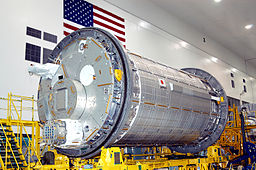
STS-124 delivered the Pressurized Module (PM) of the Japanese Experiment Module (JEM), called Kibō, to the International Space Station (ISS). Kibō was berthed to the Harmony module and the pressurized section of the JEM Experiment Logistics Module, brought up by the STS-123 crew, was moved from Harmony to the JEM-PM. The Japanese Remote Manipulator System, a robotic arm, was also delivered by STS-124 and attached to Kibō. The entire Kibō laboratory was brought up over three missions. All the modules were manufactured at the Tsukuba Space Center and were shipped to the KSC SSPF for launch processing. It is manufactured from stainless steel and titanium.
Discovery carried with it replacement parts in a mid-deck locker for a malfunctioning toilet on the International Space Station. The crew had been using other facilities for waste until the new replacement parts were installed on the Zvezda module of the ISS.
Flying with the STS-124 crew was an action figure of Buzz Lightyear, a fictional character in the Toy Story franchise. Ken Ham, pilot of the STS-124 mission, brought with him episodes of ESPN Radio's Mike and Mike in the Morning, and a plastic microphone stand with the ESPN logo on it. Along with those, a yellow jersey from Lance Armstrong's record-setting seven victories at the Tour de France bicycle race, the backup jersey Eli Manning took to the Super Bowl, and the last jersey that American Major League Baseball's Craig Biggio wore in a game were placed inside the orbiter's lockers.
With the completion of STS-124, the next permanent pressurized module would not be delivered to the ISS by a Space Shuttle until STS-130 brought up Tranquility in February 2010.
Crew seat assignments
| Seat | Launch | Landing |  Seats 1–4 are on the flight deck. Seats 5–7 are on the mid-deck. |
|---|---|---|---|
| 1 | Kelly | ||
| 2 | Ham | ||
| 3 | Nyberg | ||
| 4 | Garan | ||
| 5 | Fossum | ||
| 6 | Hoshide | ||
| 7 | Chamitoff | Reisman | |
Mission background
The mission marked:
- 154th NASA crewed spaceflight
- 123rd Space Shuttle flight since STS-1
- 98th post-Challenger mission
- 10th post-Columbia mission
- 11th flight remaining in the shuttle program
- 26th flight to the ISS
- 35th flight for shuttle Discovery
- 3rd shuttle mission in 2008
Shuttle processing
| This section includes a list of general references, but it lacks sufficient corresponding inline citations. Please help to improve this section by introducing more precise citations. (February 2024) (Learn how and when to remove this message) |
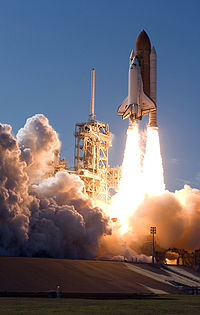
On April 26, 2008 Discovery was rolled over to the Vehicle Assembly Building (VAB) from its processing bay in the Orbiter Processing Facility. Once in the VAB it was lifted vertically and mated with its external tank and solid rocket boosters on April 28, 2008. At the end of a week-long prep schedule on May 2, 2008, at 23:47 EDT the stack was rolled out to launch pad 39A on top the Mobile Launch Platform. Carried by the Crawler Transporter, Discovery arrived and was secured at LC-39A on May 3, 2008, at 06:06 EDT. The payload canister containing the JEM was rolled out to the Payload Changeout Room at the pad on April 29, 2008, and was later installed into Discovery's payload bay on May 5, 2008. The STS-124 crew arrived at Kennedy Space Center on May 6, 2008, for the 3-day Terminal Countdown Demonstration Test and returned to Johnson Space Center on May 9, 2008, after completion of the launch dress rehearsal. After many flight readiness review tests, Discovery was given a go for a May 31, 2008, launch. Discovery launched on May 31, 2008, at 21:02 UTC.
Mission timeline
May 31 (Flight day 1, Launch)
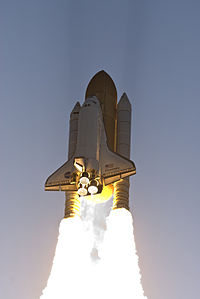

The Space Shuttle Discovery launched from the Kennedy Space Center at 17:02 EDT local time. Debris from the fuel tank was minimal.
"While we've all prepared for this event today, the discoveries from Kibo will definitely offer hope for tomorrow," said Discovery's commander Mark Kelly just before launch. "Now stand by for the greatest show on Earth."
Launch pad damage
One of the trenches at launch pad 39A that channels flames away from the shuttle during lift-off was significantly damaged. The subsequent mishap investigation found that the damage was the result of carbonation of epoxy and corrosion of steel anchors which held the refractory bricks in place. These had been exacerbated by the fact that hydrochloric acid is an exhaust by-product of the solid rocket boosters. Repairs to the trench were completed before the STS-125 mission's then scheduled launch attempt on October 8, 2008. In fact STS-125 finally launched in May 2009, and in the meantime STS-126 (November 2008) and STS-119 (March 2009) had both been successfully launched from pad 39A.
June 1 (Flight day 2)
During the first full day in space, Ham and Nyberg completed a limited inspection of the shuttle's thermal protection system using the end effector camera of the shuttle's robotic arm. The crew also installed the centerline camera and extended the orbiter's docking system ring to prepare Discovery' for arrival at the space station.
June 2 (Flight day 3)
Discovery docked with the space station at 18:03 UTC and the hatches opened at 19:36 UTC. Greg Chamitoff officially joined the Expedition 17 crew, replacing Garrett Reisman.
June 3 (Flight day 4)
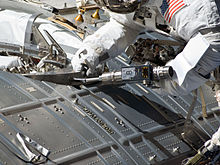
Mike Fossum and Ron Garan completed a six-hour-forty-eight-minute spacewalk at 23:10 UTC. During the excursion, the pair retrieved the Orbiter Boom Sensor System, serviced and inspected components of a Solar Alpha Rotary Joint and prepared the JEM-PS component of the Kibō laboratory for installation. Karen Nyberg and Akihiko Hoshide, using the station's robotic arm, removed the JEM-PS from the shuttle's payload bay and latched it in place on the Harmony node, completing the task at 23:01 UTC.
June 4 (Flight day 5)

The hatch to the Kibō lab was opened at 21:05 UTC. The crew also repaired the malfunctioning ISS toilet.
June 5 (Flight day 6)
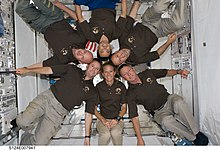
Fossum and Garan completed the second STS-124 spacewalk. The 7-hour, 11-minute excursion ended at 22:15 UTC. Prior to heading outside spacewalker Garan stated "Mike and I are getting ready to go out the door for our second spacewalk today. It's going to be a wonderful day."
June 6 (Flight day 7)
The crew moved the Kibō Logistics Module from Harmony to the Pressurized Module.
June 7 (Flight day 8)

Hoshide and Nyberg moved two of the six joints on the Japanese Kibō lab's robotic arm for the first time, maneuvering them very slightly with a series of commands. With the mission at its midpoint astronaut Karen Nyberg commented that "the week has gone way too fast."
June 8 (Flight day 9)
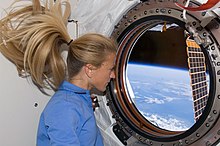
Fossum and Garan conducted the third and final spacewalk, replacing an empty nitrogen tank and collecting a sample of debris from the solar array.
June 9 (Flight day 10)
Kibō's robot arm was extended to its full 33 feet, with all six joints tested. The astronauts also opened the hatch to the Kibō's storage unit.
June 10 (Flight day 11)
The shuttle closed the hatch connecting it to the space station at 19:49 UTC.
"It's amazing what's going on up here," said Chamitoff. "This is just the beginning. Overall, the mission's been a great success," said Kelly from space. "I certainly have a great crew and they're well trained, but there's also a little luck involved."
June 11 (Flight day 12)
Discovery undocked from the International Space Station's Harmony Module, at 11:42 UTC. Discovery then conducted a fly-by of the ISS, so pictures could be taken. Saying goodbye to the ISS and its crew, commander Kelly said "We wish them the best with their expedition and we hope we left them a better, more capable space station than when we arrived. Sayonara."
Afterwards the crew of Discovery conducted the late inspection of the shuttle's Thermal Protection System that was unable to be performed as usual on Flight Day 2, due to the size of the Kibō Pressurized Module.
June 12 (Flight day 13)
Flight day 13 was a rare off-duty day. The only major projects were stowage of the Orbiter Boom Sensor System (OBSS) and an orbit adjustment burn.
During the day, pilot Kenneth Ham conducted an interview with Mike Greenberg and Mike Golic of ESPN, to be aired on their radio show, Mike and Mike in the Morning, the following morning on ESPN Radio and ESPN2.
June 13 (Flight day 14)
The crew conducted routine testing of the steering jets and an examination of the flight control system. During these tests, a shiny object was noticed trailing the shuttle. This was identified as a thermal clip from the shuttle's rudder speed brake, and should pose no danger during landing.
June 14 (Flight day 15, Landing)

The crew worked through their lengthy list of deorbit preparations, which continued for most of the day. They closed the payload bay doors at 11:30 UTC, which took place without incident. All of Discovery's systems were nominal, and with the weather looking very good at KSC the deorbit burn took place on schedule at 14:10 UTC for landing on runway 15 at 15:15 UTC.
At 12:00 UTC, the decision was made to use runway 15 rather than 33. This decision was made based on the sun glare that would be present on the Commander's window as he lined up Discovery with the runway.
Extra-vehicular activity
Three spacewalks were scheduled and completed during STS-124. The cumulative time in extra-vehicular activity during the mission was 20 hours and 32 minutes.
| EVA | Spacewalkers | Start (UTC) | End (UTC) | Duration |
|---|---|---|---|---|
| EVA 1 | Ronald J. Garan Jr. Michael E. Fossum |
June 3, 2008 16:22 |
June 3, 2008 23:10 |
6 hours, 48 minutes |
| Released straps on the shuttle's robotic arm elbow joint camera, transferred the OBSS back to shuttle. Prepared the Japanese Experiment Module, Pressurized Module (JEM-PM), named Kibō, for installation. Replaced a trundle bearing assembly on the starboard Solar Alpha Rotary Joint, and inspected damage on the SARJ. | ||||
| EVA 2 | Garan Fossum |
June 5, 2008 15:04 |
June 5, 2008 22:15 |
7 hours, 11 minutes |
| Installed covers and external equipment to Kibō, prepared for the relocation of ELM-PS. Prepared a nitrogen tank assembly for removal, and the new tank was stowed on an External Stowage Platform to prepare for installation. Removed a television camera with failed power supply. | ||||
| EVA 3 | Fossum Garan |
June 8, 2008 13:55 |
June 8, 2008 20:28 |
6 hours, 33 minutes |
| Removed and replaced the starboard nitrogen tank assembly. Finished outfitting the Kibō laboratory. Reinstalled a television camera with a repaired power supply. | ||||
Wake-up calls
NASA began a tradition of playing music to astronauts during the Gemini program, which was first used to wake up a flight crew during Apollo 15. Each track is specially chosen, often by their families, and usually has a special meaning to an individual member of the crew, or is applicable to their daily activities.
Contingency mission
STS-326 was the designation given to the Contingency Shuttle Crew Support mission which would have been launched in the event that Discovery became disabled during STS-124. It would have been a modified version of the STS-126 mission of Endeavour, which would have involved the launch date being brought forward. The crew for this mission would have been a four-person subset of the full STS-126 crew, namely:
- Christopher Ferguson – Commander
- Eric A. Boe – Pilot
- Stephen G. Bowen – Mission Specialist, extravehicular 2
- Heidemarie Stefanyshyn-Piper – Mission Specialist, extravehicular 1
Media
- Space Shuttle Discovery launches on STS-124
-
 Composite image of the US Segment of the ISS taken during EVA
Composite image of the US Segment of the ISS taken during EVA
References
![]() This article incorporates public domain material from websites or documents of the National Aeronautics and Space Administration.
This article incorporates public domain material from websites or documents of the National Aeronautics and Space Administration.
- "STS-124". Archived from the original on April 25, 2018. Retrieved April 24, 2018.
- "Mission Information – STS-124". NASA. Archived from the original on March 14, 2022.
- "Page 19" (PDF). Archived (PDF) from the original on June 8, 2017. Retrieved August 22, 2010.
- NASA (2008). "NASA Updates Target Launch Date for Next Space Shuttle Flight". NASA. Archived from the original on December 28, 2018. Retrieved March 31, 2008.
- NASA (2007). "NASA Assigns Crew for Shuttle Mission to Install Japanese Lab". NASA. Archived from the original on November 20, 2007. Retrieved October 30, 2007.
- Withers, Stephen (2007). "Crew assignments for space shuttle mission STS-126 have been revised following the resignation of an experienced astronaut". iTWire. Archived from the original on June 5, 2008. Retrieved November 22, 2007.
- "Preflight Interview: Mark Kelly, Commander". Nasa.gov. NASA. June 20, 2008. Archived from the original on February 3, 2013. Retrieved August 22, 2010.
- "Montreal-born astronaut brings bagels into space". CTVNews. June 1, 2008. Archived from the original on October 16, 2012.
- Block, Irwin (June 3, 2008). "Here's proof: Montreal bagels are out of this world". The Gazette (Montreal). p. A2. Archived from the original on June 4, 2008.
- "1J Mission - International Space Station - JAXA". iss.jaxa.jp. Retrieved February 26, 2023.
- "Buzz Lightyear to Soar with Discovery". NASA. May 29, 2008. Archived from the original on May 31, 2008. Retrieved May 29, 2008.
- "STS-124". Spacefacts. Retrieved April 25, 2024.
- "Space Shuttle Discovery Arrives at Launch Pad, Countdown Test Set". NASA. Archived from the original on January 12, 2010. Retrieved December 30, 2009.
- "Discovery blasts off for space station". CNN. Archived from the original on June 3, 2008. Retrieved June 2, 2008.
- "SPACE.com – Shuttle Discovery Launches Space Station's Largest Lab". Space.com. May 31, 2008. Archived from the original on January 5, 2010. Retrieved June 14, 2008.
- "SPACE.com". Space.com. June 2, 2008. Archived from the original on August 15, 2009. Retrieved July 10, 2008.
- Lilley, Steve K. (August 2010). "Hit the Bricks" (PDF). System Failure Case Studies. 4 (8). NASA: 1–4. Archived from the original (PDF) on 28 September 2011. Retrieved 20 July 2011.
- "NASA Image of the Day". Archived from the original on July 11, 2008. Retrieved July 10, 2008.
- "STS-124 MCC Status Report No. 03". NASA. Archived from the original on July 8, 2017. Retrieved June 3, 2008.
- "STS-124 MCC Status Report No. 05". NASA. Archived from the original on October 27, 2020. Retrieved June 3, 2008.
- "STS-124 MCC Status Report No. 07". NASA. Archived from the original on August 7, 2008. Retrieved June 5, 2008.
- "STS-124 MCC Status report". Nasa.gov. Archived from the original on September 25, 2020. Retrieved August 22, 2010.
- Harwood, William (June 4, 2008). "Russian toilet pump replaced in space station". SpaceflightNow. Archived from the original on December 4, 2022. Retrieved December 3, 2022.
- "STS-124 MCC status Report". Nasa.gov. Archived from the original on October 27, 2020. Retrieved August 22, 2010.
- "SPACE.com – Astronauts to Add Camera Eyes to New Station Lab". Space.com. June 5, 2008. Archived from the original on June 7, 2008. Retrieved June 14, 2008.
- "STS-124 MCC status Report". Nasa.gov. Archived from the original on November 26, 2010. Retrieved August 22, 2010.
- Shuttle astronauts prepare robot arm for 1st use Archived June 7, 2008, at the Wayback Machine
- "SPACE.com – Shuttle Crew Hits Mission Midpoint with Robot Arm Test". Space.com. June 7, 2008. Archived from the original on June 11, 2008. Retrieved June 14, 2008.
- Astronauts breeze through their 3rd spacewalk Archived June 8, 2008, at the Wayback Machine
- Astronauts wrap up space station work Archived June 9, 2008, at the Wayback Machine
- "STS-124 MCC Status Report #21". Archived from the original on March 17, 2010. Retrieved April 25, 2010.
- "SPACE.com – Space Shuttle Flight a 'Great Success,' Astronauts Say". Space.com. June 9, 2008. Archived from the original on June 13, 2008. Retrieved June 14, 2008.
- "SPACE.com – Shuttle Discovery Undocks From Space Station". Space.com. June 11, 2008. Archived from the original on June 13, 2008. Retrieved June 14, 2008.
- ^ "NASA – Space Shuttle". Archived from the original on April 25, 2013. Retrieved June 14, 2008.
- "NASA identifies shiny object trailing shuttle". CNN. June 13, 2008. Archived from the original on August 1, 2008. Retrieved August 22, 2010.
- "NASA Mission Summary, STS-124" (PDF). NASA. April 9, 2008. Archived (PDF) from the original on May 24, 2011. Retrieved April 9, 2008.
- NASA (2008). "STS-124 EVA Briefing Graphics". NASA. Archived from the original on July 2, 2017. Retrieved October 6, 2008.
- NASA (2008). "STS-124 MCC Status Report No. 07". NASA. Archived from the original on August 7, 2008. Retrieved October 6, 2008.
- ^ NASA (2008). "STS-124 MCC Status Report No. 11". NASA. Archived from the original on July 6, 2017. Retrieved October 6, 2008.
- Fries, Colin (June 25, 2007). "Chronology of Wakeup Calls" (PDF). NASA. Archived (PDF) from the original on June 20, 2010. Retrieved August 13, 2007.
- ^ Bergin, Chris (April 15, 2007). "NASA sets new launch date targets through to STS-124". NASASpaceflight. Archived from the original on March 3, 2016. Retrieved August 21, 2007.
External links
- Official NASA Space Shuttle Page, includes images and data, constantly updated as STS-124 progresses
- NASA's official STS-124 Launch Blog Archived February 22, 2011, at the Wayback Machine
- NASA-TV: NASA's Television Station Which Will Broadcast the Mission of STS-124 from Mission Control in Houston and Space
- Up to the minute status updates for STS-124 mission updates page on spaceflightnow.com
- STS-124 Official Flight Kit manifest page on collectspace.com
| Space Shuttle Discovery (OV-103) | ||
|---|---|---|
| Completed flights |  | |
| Status |
| |
| On display | ||
| Related |
| |
| Human spaceflights to the International Space Station | ||
|---|---|---|
| See also: ISS expeditions, Uncrewed ISS flights | ||
| 1998–2004 |
|  |
| 2005–2009 | ||
| 2010–2014 | ||
| 2015–2019 |
| |
| Since 2020 |
| |
| Future | ||
| Individuals | ||
| Vehicles |
| |
| ||
| U.S. Space Shuttle missions | |||||||||||
|---|---|---|---|---|---|---|---|---|---|---|---|
| Completed (crews) |
| ||||||||||
| Cancelled | |||||||||||
| Orbiters | |||||||||||
| |||||||||||
| ← 2007Orbital launches in 20082009 → | |
|---|---|
| January | |
| February | |
| March | |
| April | |
| May | |
| June | |
| July | |
| August | |
| September | |
| October | |
| November | |
| December | |
| Launches are separated by dots ( • ), payloads by commas ( , ), multiple names for the same satellite by slashes ( / ). Crewed flights are underlined. Launch failures are marked with the † sign. Payloads deployed from other spacecraft are (enclosed in parentheses). | |
Categories: